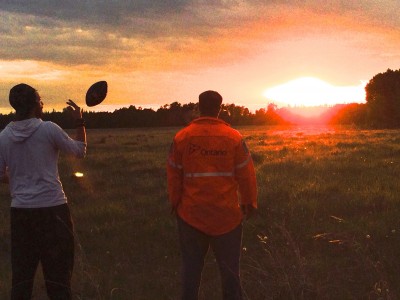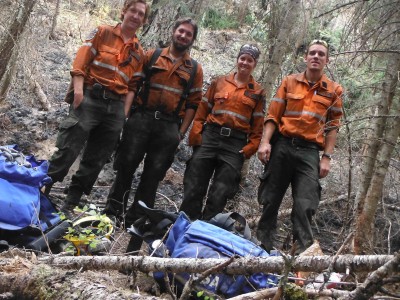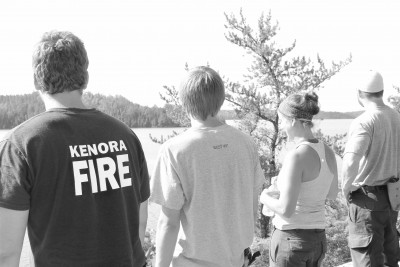 “Hey Root, what time is it?”
“Hey Root, what time is it?”
This question prompts one response: chew o’clock. My crew member will start packing his tin, and I’ll grab a Bandit pouch from mine. One hand on the steering wheel, the other on my dip bottle, I shake my head —when did this happen? Having been taught the risks associated with smoking and drinking at a young age, I can remember crying after seeing my dad smoke a celebratory cigar once, thinking he would soon die of lung cancer. So when did I start chewing tobacco, and why?
In fact, the answer to both of those questions is neither complex, nor hidden. The first time I packed a dip of Beechnut was on a firefighting tour in Montana, because my crew boss simply asked “Hey Root, what time is it?” It wasn’t initiation, or peer pressure, but it meant I was one of the guys. It was a bonding experience. I never felt like I had to, or that if I took the dip out, I would be ridiculed. I never felt like I would lose their respect if I stopped. It was after lunch, on the side of an American mountain, when I simply had nothing to lose in saying “chew o’clock” and packed a big lipper to bond a little bit more with the boys.

Crew Chew
It was the same thought process one night on tour. I was walking back to my tent after dinner, and I got the upward head nod, requesting my attention.
“You wanna come for a walk later?”
A pause. And a look, straight into my eyes. This wasn’t an offer to be turned down. I had nothing to lose.
The five of us walked shoulder-to-shoulder, hands in our pockets, 40-minutes down the dirt road away from camp. The sun was settling down for the night, and the cool air was moving in. Coyotes yelped at each other in the distance. It was obvious that he who invited me out, the eldest, was our alpha. When he stopped, we stopped. When he talked, we listened. We all knew that he was our unspoken pack leader. His stories were captivating, not because of the content, but the way in which he spoke. He spoke in a series of images. Short fragments of vivid memories that he relived. We would walk and stare straight into the story he was painting, feeling his fear, confusion, or excitement. A short bit of dialogue. Pause. Some hand motions to outline figures. Pause. Adjectives and adverbs to fill in the painting. And we would continue to walk.
I’m not sure if it was the sweet evening air, or the fatigue from long work days, but I remained completely silent. Just listening. Of the entire 20 rangers we were working with, only five of us went for this evening walk, and I was one of them. Listening in on the stories. Reaping the benefits of the lessons. And bonding with boys. The smell of burning sweet grass filed our lungs, the shape of experiences guided our visions, and the alpha led us down his painted trails.
I started to think about where I was. What I was doing. Who I was with. I was thinking about my environment. We often hear about the influence of our social environment on overall health—experienced levels of support, guidance, and connectedness. The availability of your parents celebrating your successes, the impact of your peers encouraging risky behaviours, or the personal desire to create a certain self-image—we’ve all felt the influence of our social environment. While we know that some social environment elements can be detrimental to our health, and professionals prove time and time again why they are bad for us, we still see higher rates of smoking and alcohol consumption in First Nations populations. I’m sure this fact remains maddening. But let’s not forget the importance of culture.
 My young and eager crew member was trying to quit smoking at the beginning of the fire season, seeking help from an e-cigarette. With people around him constantly offering a smoke, he quickly accepted his submission to the real thing. So when we were packing to leave on tour, he asked me how many packs of cigarettes he should bring.
My young and eager crew member was trying to quit smoking at the beginning of the fire season, seeking help from an e-cigarette. With people around him constantly offering a smoke, he quickly accepted his submission to the real thing. So when we were packing to leave on tour, he asked me how many packs of cigarettes he should bring.
“Bring a carton. You’re going to need them,” I said.
That’s 200 cigarettes for 19 days.
People outside of the program don’t understand this. “Just use the lack of accessibility to cigarettes to stop smoking. You don’t have them, you won’t smoke them.”
… But you will. That’s the problem. There are enough smokers in the program, that I’ve seen guys hike kilometers through the bush to meet up with people who have smokes. As ironic as it may seem, smoking is part of the culture in the fire program. You’re not always lighting up a cigarette for the addiction or the coping—it’s for the socializing, the bonding, the sharing. It’s easy for anyone outside the fire program to stand there, arms crossed, head shaking, foot tapping, and criticize how it’s ridiculous that so many firefighters smoke cigarettes, and question why they can’t use lack of accessibility in the bush as the perfect opportunity to kick the dirty awful habit.
Similarly, it’s simple for someone in southern Ontario, to read statistics all day, roll his eyes, and shake his head, and conclude that First Nations populations have higher rates of cigarette smoking and alcohol consumption, and that their social environment is negatively impacting overall health. But it must be understood and accepted that often these habits are not simply chosen habits due to teenage peer pressure, or acts of rebellion—they are chosen because they are normal. It’s part of bonding with elders. It’s part of the culture. It’s part of story and wisdom sharing.
Those evening walks, walking shoulder-to-shoulder. The sweet air filling our bodies. The cool, stale air wrapping our skin. There I was; socks and flip flops, Giant Tiger sweatpants, and a ratty Carleton U sweatshirt. Completely silent, listening, watching, and reflecting; I was one of the guys.
Author Ariel Root is currently in Kenora in her fourth season working as a forest fire fighter for the Ontario Ministry of Natural Resources and Forestry. She has a BSc in Food Science & Nutrition from Carleton University in 2012, and is currently a graduate student in the Health Science, Technology and Policy program at Carleton University. She has been featured on APTN’s new hit TV show, Playing with Fire, Season 2.
Come back for next week’s instalment.
Photos by Ariel Root
Follow us on twitter!